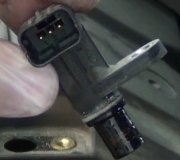Very bad idea. Current flowing through a wire sets up a magnetic field around it, and a magnetic field around a wire induces a voltage into it and others nearby. That is part of the basic principle of how all motors and generators work. The engineers go through a lot of research and development to position wires within a harness and a harness close to other magnetic fields so pulses are not introduced that would confuse computers reading digital signals. Re-positioning wires is a common cause of elusive false triggering of anti-lock brakes, and impossible-to-diagnose engine running problems.
The camshaft position sensor's black/light blue wire is the ground wire and is shared by other sensors. You should find 0.2 volts on it because that circuit goes through the engine computer's circuitry where it is monitored, then to ground.
The 5.0 volt feed wire is the violet/white wire. It feeds multiple sensors, so a problem with that will set numerous diagnostic fault codes.
The signal wire is the tan/yellow wire where you also found 5 volts. That is entirely possible, depending on the type of sensor you have. Some switch strictly on camshaft position. You will see the voltage drop to close to 0 volts when you rotate the engine slowly by hand. Only a three-wire sensor, with its circuitry built in, can switch like that. All two-wire position sensors, and a few three-wire position sensors rely on the movement of the magnetic field to generate a signal pulse. In this case the movement is in the form of a metal blade or tooth passing by the magnet in the sensor, and disturbing its magnetic field. You cannot rotate an engine fast enough by hand to make one of these change state. To further aggravate the misery, you cannot measure the signal voltage with a digital voltmeter. They take a reading, analyze it, then display it while it takes the next reading. It could take a whole bunch of readings while the sensor is at 5 volts, and display that, or the same thing with 0 volts, but more commonly it alternates between those two readings and what it displays bounces around in an impossible-to-read fashion. Voltage readings are totally worthless in these circuits. If you were to view the signals on an oscilloscope, you would see a square wave that changes instantly between 0 volts and 5 volts. The actual voltage is unimportant. It is the timing of the pulses the computer looks at to determine when to fire ignition coils and injectors.
The easiest way to know if these sensors are working is with a scanner. Typically, a diagnostic fault code for one of these sensors does not have time to set just from cranking the engine, but if the failure occurred while driving, a fault code will set while the stalled engine is coasting to a stop. Read the fault codes first. If you find one for a sensor, it is important to understand they never ever say to replace a part or that one is bad. They only indicate the circuit or system that needs further diagnosis, or the unacceptable operating condition. First we have to rule out wiring and connector terminal problems.
When there are no related fault codes, the scanner can display these sensors under "live data". They will be listed with a "no" or "present" during cranking to indicate whether those signals are showing up at the engine computer.
Most likely the reason you are seeing some voltage feeding the cam sensor is the Engine Computer needs up to twenty minutes to go to "sleep" mode after turning off the ignition switch. Measure that voltage well after that twenty minutes and see what you find.
Monday, September 4th, 2017 AT 11:19 PM


